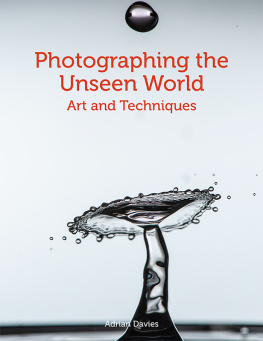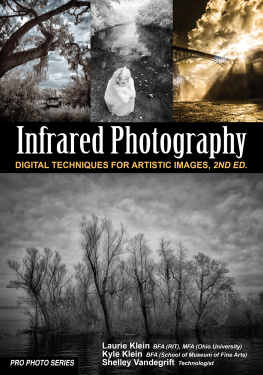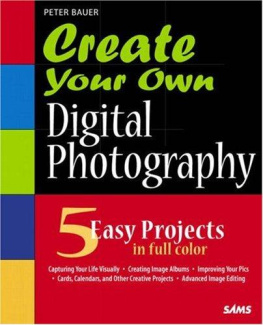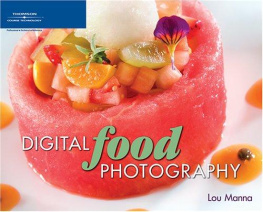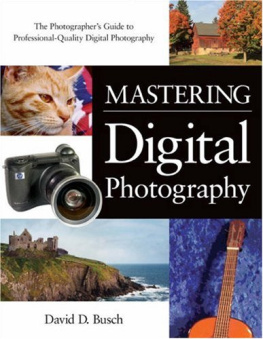Contents
DIGITAL ULTRAVIOLET AND INFRARED PHOTOGRAPHY
Digital Ultraviolet and Infrared Photography discusses the growing number of applications of ultraviolet and infrared photography. Scientific and technical photographers, such as those engaged in scientific, medical, forensic and landscape and wildlife photography routinely use ultraviolet and infrared techniques, and these techniques are growing in use in creative photography.
This is the first book to address the application and potential for both ultraviolet and infrared photography in both science and art. The author, Adrian Davies, discusses the how-to of ultraviolet and infrared digital recording with a dissection of techniques, camera requirements and camera conversion, a useful appendix of resources and equipment currently available and inspirational image examples throughout. Written for the seasoned photographer, Digital Ultraviolet and Infrared Photography is an essential read for photographers using these tools either professionally or creatively.
Adrian Davies is a passionate naturalist and conservationist, combining these passions with photography to investigate how insects see plants through ultraviolet techniques. He has written 10 books, including Digital Imaging for Photographers, The Focal Digital Imaging A-Z, and Close-Up and Macro Photography. After a 27-year career as a senior lecturer in the photography and imaging department at NESCOT College in the UK, he now works as a freelance photographer, running workshops for organisations such as the Royal Horticultural Society and the Royal Photographic Society, and giving lectures to camera clubs and natural history societies.
ABOUT THE SERIES APPLICATIONS IN SCIENTIFIC PHOTOGRAPHY
Like all fields, there are many subspecialties within the broad field of scientific photography. While each seemingly specialised, there are areas within the individualised fields of science where photography is practised in generalised ways as well. The Applications in Scientific Photography series was produced to become an industry resource, in homage to the seventeen books created for the Time Life Photography series in the 1970s, which outlines various aspects of photography for the working professional and student, including technology, methods, applications, tools and important photographers.
The third book in the Applications in Scientific Photography series is Digital Ultraviolet and Infrared Photography. The book discusses the growing number of applications of ultraviolet and infrared photography. Scientific and technical photographers, such as those engaged in scientific, medical, forensic and landscape and wildlife photography, routinely use ultraviolet and infrared techniques, and these techniques are growing in use in creative photography.
Each subsequent title in the series has been designed to share the best practices from each discipline using applied and practical strategies. Each book in the series will deconstruct and emphasise how images are considered scientific data and the end facts of an experiment or photographic documentation/survey.
Titles in the Series
Laboratory Imaging and Photography: Best Practices for Photomicrography & More
Michael Peres, Rochester Institute of Technology
Fundamentals of Forensic Photography: Practical Techniques for Evidence Documentation on Location and in the Laboratory
Keith Mancini and John Sidoriak
Digital Ultraviolet and Infrared Photography
Adrian Davies
DIGITAL ULTRAVIOLET AND INFRARED PHOTOGRAPHY
Adrian Davies

First published 2018
by Routledge
711 Third Avenue, New York, NY 10017
and by Routledge
2 Park Square, Milton Park, Abingdon, Oxon OX14 4RN
Routledge is an imprint of the Taylor & Francis Group, an informa business
2018 Taylor & Francis
The right of Adrian Davies to be identified as the author of this work has been asserted by him in accordance with sections 77 and 78 of the Copyright, Designs and Patents Act 1988.
All rights reserved. No part of this book may be reprinted or reproduced or utilised in any form or by any electronic, mechanical, or other means, now known or hereafter invented, including photocopying and recording, or in any information storage or retrieval system, without permission in writing from the publishers.
Trademark notice: Product or corporate names may be trademarks or registered trademarks, and are used only for identification and explanation without intent to infringe.
Library of Congress Cataloging-in-Publication Data
A catalog record for this book has been requested
ISBN: 9 78-1-138-20016-6 (hbk)
ISBN: 9 78-1-138-20017-3 (pbk)
ISBN: 978-131-5515-09-0 (ebk)
Typeset in Photina MT and Conduit
by Florence Production Ltd, Stoodleigh, Devon, UK
Contents
5.7.13 Corals and Other
Underwater Subjects
I first became interested in ultraviolet (UV) and infrared (IR) photography as a student in scientific photography at the Harrow School of Photography in the UK in the 1970s. Over the ensuing years I occasionally dabbled with it, but never seriously, due to problems with darkroom issues and film costs.
I am fascinated by the natural world, and started looking at how flowers appear to insects in the early 1990s, using analogue film, UV filters and a fledgling version of Photoshop to combine visible light and UV images. That work culminated in an MSc thesis in 1994.
My aim in writing this book is to help rekindle interest in this fascinating area of photography, showing how it is possible to produce fascinating and scientifically useful images without having to invest in hugely expensive or complicated equipment. Throughout, I have strived to achieve as high quality as possible in the images, both in terms of lighting and resolution. There is huge potential, both from a scientific and technical side and the production of creative images.
The graphs in this book have come from a variety of sources, and to try and get some consistency, have been redrawn. If you need more specific data, the original graphs are usually available on manufacturers websites.
Also, throughout the book, the various types of UV and IR illumination are referred to as sources rather than light, simply because light is something that we can see, and of course we normally cannot see UV or IR.
I produced nearly 300 images for the book, but could obviously not include them all. I have put together a website called Imaging the Invisible (www.imagingtheinvisible.com), where many more images can be seen, together with new ones shot since producing the book.
A large number of people have helped me in the production of this book, answering phone or email queries, allowing me to visit them, photographing specimens or even modelling for me. Apologies if your specimens did not make the final edit! Thanks in particular to my family, Fran, Bryony, Robin and Kat, for putting up with all sorts of often strange requests! The editor Dr Michael Peres was very patient in answering my questions, as were the staff at Focal Press. A big thanks to you all! Apologies if I have missed anyone!
Andrea Blum and Bjrn Rrslett and various members of the ultraviolet photography.com forum
Warren Brennan, BBG Sports
David Bryden, University of Derby
Matt Cass, Acuity Forensics
Antonino Cosentino, Cultural Heritage Science Open Source


